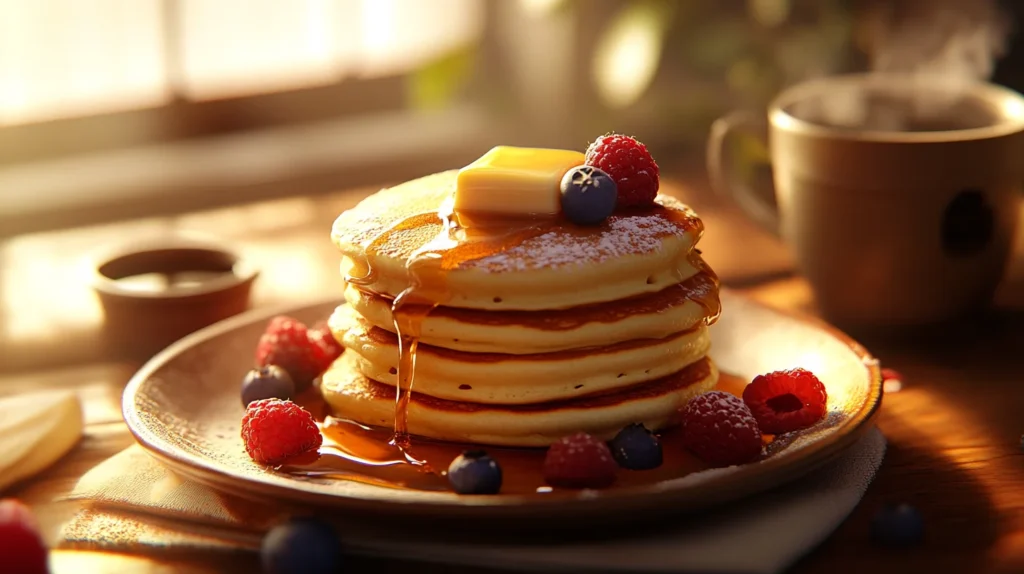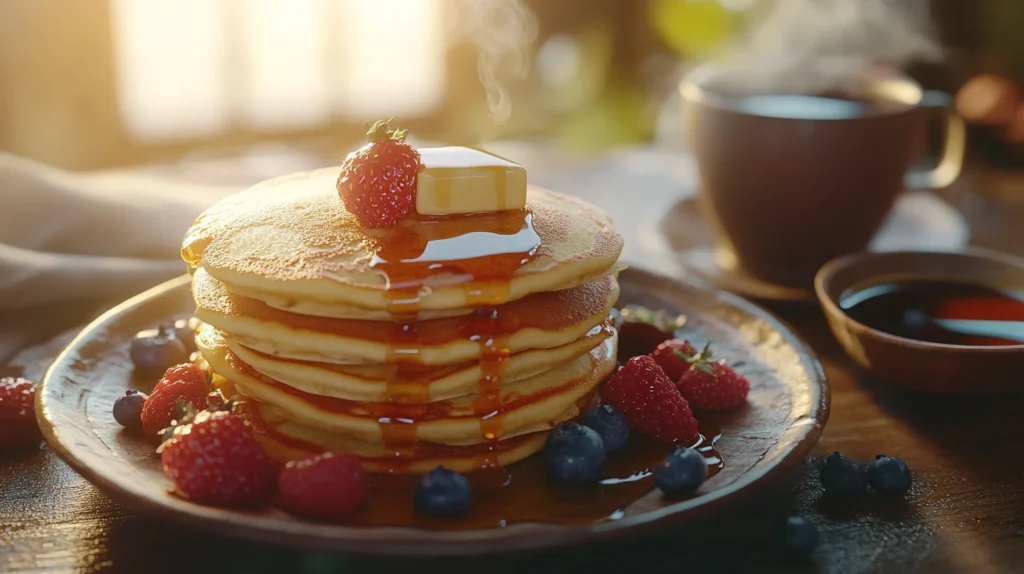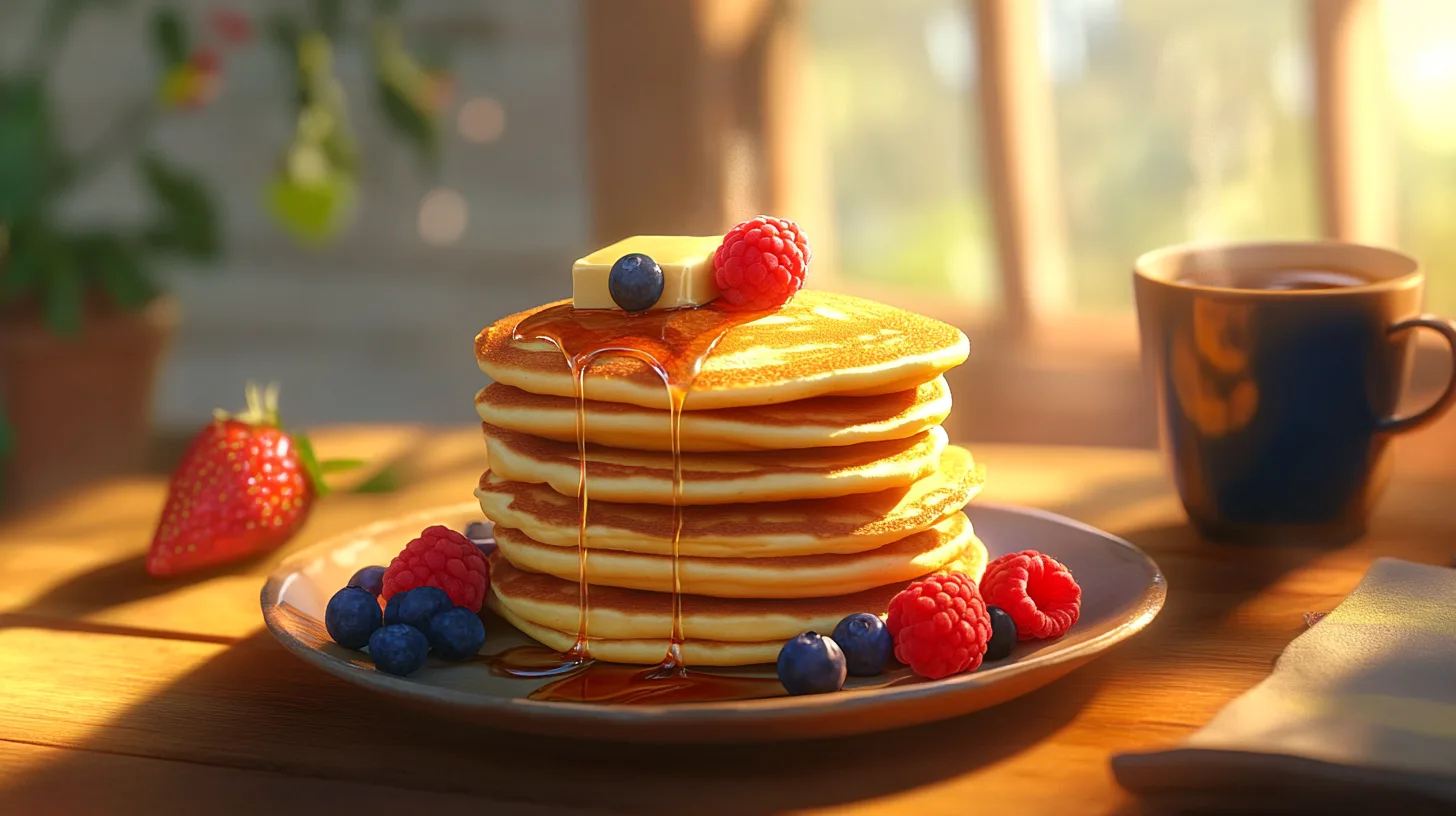Pancake Breakfast – Fluffy Delights for Every Gathering
A pancake breakfast is more than just a morning meal; it embodies the joy of gathering with loved ones, indulging in deliciously fluffy stacks, and savoring moments that turn into cherished memories. This beloved tradition has transcended generations and cultures, making it a delightful experience for people around the world.
The Delightful Tradition of Pancake Breakfasts
Pancake breakfasts are an age-old tradition that brings people together over plates filled with warm, buttery pancakes. Whether enjoyed on a lazy Sunday morning or served up at communal gatherings like fundraisers or family reunions, pancakes have a unique ability to evoke feelings of comfort and nostalgia. The tradition varies from region to region, but one thing remains consistent: they are always made with love.
The charm of pancake breakfasts lies not only in the delicious food but also in the atmosphere they create. Friends and family gather, share stories, and bask in the warmth of each other’s company. This shared experience elevates a simple meal into something memorable, creating bonds and fostering connections.
The Origin and History of Pancakes
The history of pancakes stretches back thousands of years, with evidence suggesting that ancient civilizations were whipping up variations of this beloved dish long before modern recipes existed.
In fact, as far back as 5,000 years ago, the Greeks and Romans were known to consume flat cakes made from wheat flour, olive oil, honey, and curdled milk. These early versions differ significantly from today’s fluffy iterations but showcase the timeless appeal of pancakes.
Over time, different cultures adopted and adapted these flat cakes to suit their tastes and available ingredients. In medieval Europe, pancakes evolved into what we know now, becoming synonymous with festivities such as Shrove Tuesday, where they were consumed to use up rich ingredients before Lent. As settlers traveled, they took their pancake traditions with them, leading to the diverse varieties we enjoy today.
Cultural Significance of Pancake Breakfasts Worldwide
Across the globe, pancake breakfasts hold cultural significance that transcends borders. From the American pancake stack dripping with syrup to the French crêpe served with sweet or savory fillings, each culture has crafted its unique take on this classic dish.
In Sweden, for instance, the tradition of “plättar” features smaller, thinner pancakes typically enjoyed during celebrations or special occasions. Similarly, in Japan, “okonomiyaki” stands out as a savory pancake filled with ingredients like cabbage and meat, often enjoyed during festivals.
This celebration of pancakes reflects a universal love for food that brings people together, whether through holiday traditions or everyday meals. By exploring these cultural nuances, we not only appreciate pancakes’ diversity but also gain insight into the values and histories that shape our culinary practices.
Popular Variations of Pancakes Across Cultures
As mentioned earlier, pancakes come in various forms worldwide, each reflecting local flavors and customs.
Considering the classic American pancake, you may envision thick, fluffy discs served with butter and maple syrup, epitomizing comfort food. Yet, in Mexico, “hotcakes” take on a slightly different profile, often featuring vanilla and cinnamon flavors that pair beautifully with fresh fruit and cream.
Meanwhile, in Eastern Europe, we encounter “blintzes,” which are thin pancakes filled with cheese or fruit, then rolled and baked—a fitting choice for festive gatherings. Even within the United States, variations abound, from blueberry pancakes bursting with fruit to chocolate-chip versions that appeal to sweet tooth indulgence.
Each variation serves as a reminder that pancakes can adapt and evolve while still providing the same sense of satisfaction and enjoyment. This versatility invites creativity, allowing families to improvise based on personal preferences and seasonal ingredients.
Essential Ingredients for a Perfect Pancake
Crafting the ideal pancake requires attention to detail, particularly when selecting ingredients. While the basics center around flour, eggs, milk, and baking powder, understanding the nuances of each component will elevate your pancake breakfast to new heights.
Choosing the right flour is crucial as it impacts the texture and flavor. All-purpose flour is commonly used, offering a balanced result, while whole wheat flour provides extra nutrition and a heartier taste. Alternatively, using specialty flours such as almond or coconut flour caters to specific dietary needs and adds a unique twist.
Milk plays another pivotal role in achieving pancake perfection. While regular dairy milk works wonders, switching to buttermilk yields tangy, tender results due to its acidity, which activates the baking soda.
Eggs contribute not only to the structure but also to the lightness of the batter. Beating egg whites separately before folding them into the batter creates an airy texture that sets fluffy pancakes apart from the rest.
Sweeteners and flavorings allow you to further personalize your pancake recipe. Beyond traditional sugar, consider honey, maple syrup, or even vanilla extract for added depth. Experimenting with spices such as cinnamon or nutmeg introduces warm notes that complement the dish beautifully.
Lastly, toppings play a vital role in finishing touches. From luscious fruit syrups to dollops of whipped cream, the options are limitless. Don’t forget about nuts, chocolate chips, or yogurt for extra flair.
Flour: Choosing the Right Type
When embarking on your pancake journey, flour selection is foundational. The type of flour used directly influences the texture and consistency of your final product.
All-purpose flour reigns supreme for many home cooks, offering a balance of protein and starch that yields fluffy pancakes. However, if you’re interested in enhancing the nutritional content, whole wheat flour emerges as a popular alternative. It boasts higher fiber levels and contributes a nutty flavor, adding complexity to your breakfast spread.
For those diving into gluten-free diets, options such as almond flour or gluten-free all-purpose blends have gained traction. Almond flour creates a moist, rich pancake while gluten-free blends can mimic the fluffiness of traditional pancakes without sacrificing taste.
No matter your choice, remember that experimentation is key. You might find a blend of flours produces the ideal texture, leading to a pancake that tantalizes taste buds while satisfying dietary preferences.
Milk vs. Buttermilk: Understanding the Differences
Deciding between milk and buttermilk can dramatically alter the outcome of your pancakes. Each option serves a unique purpose in the batter that impacts taste, texture, and moisture content.
Regular milk lends a neutral flavor and allows easy incorporation of dry ingredients. Its versatility makes it a staple in many households, ensuring that pancakes remain soft and enjoyable.
On the other hand, buttermilk offers a distinctive advantage—its acidic nature reacts with baking soda, leading to extra rise and tenderness. The resulting pancake possesses a delightful tanginess that pairs harmoniously with sweet toppings.
When working with buttermilk, it’s essential to note that it may require slight adjustments in the overall recipe. For example, reducing the amount of baking powder or soda ensures balanced leavening that achieves the perfect rise without compromising flavor.
Eggs: Their Role in Achieving the Ideal Texture
Eggs serve multiple roles in pancake batter, impacting both structure and moisture. They contribute proteins that bind ingredients together, providing stability while promoting an appealing texture.
When it comes to achieving the lightest, fluffiest pancakes, consider separating the yolks from the whites. Whipping egg whites into soft peaks before gently folding them into the batter creates aeration that lifts pancakes to new heights.
Moreover, eggs enhance the richness of pancakes, complementing the sweetness of added ingredients. Don’t hesitate to experiment with additional egg types such as duck eggs or even flaxseed for vegan alternatives, each presenting a unique flavor profile and subtle nuance to your breakfast dish.
Sweeteners and Flavorings: Enhancing the Batter
Innovative sweeteners and flavorings introduce character to your pancake batter, transforming a basic recipe into something extraordinary. While granulated sugar serves its purpose well, considering alternatives like brown sugar can impart a deeper molasses flavor.
Moving beyond sugar, you might explore natural sweeteners such as maple syrup or agave nectar. These options not only add sweetness but offer distinct flavor profiles that elevate your pancake breakfast.
Furthermore, infusing your batter with vanilla extract or spices like cinnamon can create aromatic pancakes reminiscent of freshly baked goods. The magic lies in the personalization—each tweak allows your pancakes to reflect your taste while providing a sensory experience that delights everyone at the table.
Toppings and Accompaniments: The Finishing Touches
No pancake breakfast would be complete without an array of delectable toppings and accompaniments that elevate the experience. Traditional choices include maple syrup and melted butter, but the possibilities extend far beyond these classics.
Consider fresh fruit as a vibrant addition—strawberries, blueberries, and bananas bring color while introducing freshness and natural sweetness to each bite. Add a splash of lemon juice for brightness, elevating the flavor profile even further.
For those desiring a richer experience, whipped cream or yogurt transforms pancakes into a decadent treat. Incorporating nuts or dark chocolate chips adds crunch and indulgence, enticing even the most discerning palates.
Ultimately, the beauty of pancake breakfasts lies in the freedom to customize. Encourage guests to get creative, allowing them to construct their unique pancake stacks that cater to every whim.

Preparing for a Pancake Breakfast
Having understood the essential ingredients, it’s time to delve into preparing for a pancake breakfast. Preparation is key to ensuring that everything runs smoothly and everyone enjoys a memorable experience.
Creating an inviting cooking space enhances the overall ambiance, setting the stage for joyful interactions while flipping pancakes. Setting up your tools and gathering ingredients beforehand streamlines the process, avoiding unnecessary stress when hunger strikes.
Thoughtful menu planning is equally important. Offering variety caters to different tastes and dietary needs, ensuring everyone leaves satisfied. Lastly, employing effective time management techniques helps keep things organized, allowing you to focus on enjoying the moment rather than feeling rushed.
Key Tools and Utensils Needed
Preparing for a pancake breakfast means stocking your kitchen with essential tools and utensils that will make the process efficient and enjoyable.
First and foremost, a non-stick skillet or griddle is a must-have. Its smooth surface aids in evenly cooked pancakes while minimizing sticking—an absolute win for any cook. Consider investing in a cast-iron skillet for excellent heat retention and browning capabilities.
Measuring cups and spoons come next, enabling precise ingredient quantities. A whisk is indispensable for mixing the batter, while a spatula assists in flipping with finesse. Dive into the world of pancake-making with confidence by assembling your toolkit of essentials.
Additionally, having a good-quality serving platter or stacker for your finished pancakes enhances presentation and elevates the dining experience. Guests will appreciate the thoughtfulness as they indulge in a feast of fluffy delights.
Setting Up Your Cooking Space
Transform your kitchen into a delightful pancake haven by organizing your cooking space ahead of time. Before diving into the batter, ensure that your counter is tidy and free from distractions.
Arrange your ingredients within arm’s reach, utilizing bowls or containers for easy access. A helpful tip is to prepare the batter beforehand and let it rest for about 10 minutes. Resting allows the gluten to relax, resulting in lighter pancakes while aiding in flavor development.
Setting up a cooking station with all necessary tools at hand ensures smooth sailing from start to finish. You might even designate a “pancake bar” where guests can customize their creations, bringing an interactive element to the breakfast experience.
Planning the Menu: Variety is Key
While the central star of your pancake breakfast is undoubtedly the pancakes themselves, diversifying your menu is essential for delighting your guests. Beyond classic pancakes, consider offering a range of toppings, sides, and beverages that will tantalize the taste buds of everyone present.
Start with a selection of pancake variations, such as fluffy blueberry pancakes, rich chocolate chip pancakes, and savory options like potato pancakes. This allows guests to pick their favorites and encourages sharing—everyone loves trying a bit of everything!
Complement your pancake offerings with sides like crispy bacon, sausage links, or fresh fruit salads. Additionally, providing toppings ranging from whipped cream, maple syrup, and assorted jams allows guests to curate their pancake masterpieces.
Lastly, don’t forget about beverages! Coffee, tea, and fresh juices serve as perfect companions to your hearty breakfast, rounding out a truly delightful experience.
Time Management Tips for a Smooth Breakfast
Navigating a pancake breakfast involves juggling multiple tasks, particularly if you’re catering to a sizable crowd. Effective time management ensures that everything flows seamlessly, leaving you free to enjoy the moment with your guests.
Start by creating a timeline for your preparations, accounting for things like batter mixing, cooking times, and plating. Consider batching your pancakes—cooking several at once to expedite the process. If using a griddle, take advantage of the larger surface area for efficiency.
Additionally, enlist help from family members or friends. Assigning specific tasks keeps everyone engaged while alleviating pressure on the host. Finally, remember to pace yourself—creating a relaxed atmosphere enables everyone to savor the experience rather than rushing through it.
Cooking Techniques for Perfect Pancakes
Once you’ve prepared your ingredients and set the stage for a spectacular pancake breakfast, it’s time to delve into the art of cooking. With the right techniques, you’ll master the elusive quest for perfectly fluffy pancakes.
Mixing the batter skillfully is crucial, as is timing your flips to achieve golden-brown perfection. Understanding cooking temperatures and troubleshooting common pancake problems empowers you to navigate unexpected hurdles gracefully.
The Art of Mixing the Batter
Mixing pancake batter is an art form that requires a delicate touch. Aim to combine your wet and dry ingredients without overmixing, as this leads to tough pancakes. Instead, gently fold the batter until just incorporated, allowing for a few lumps to remain.
For those incorporating add-ins such as fruits or chocolate chips, add them at the end to prevent excessive mixing. Reserve some toppings for sprinkling on top while cooking, allowing them to caramelize and meld beautifully into each pancake.
Another technique worth exploring is resting the batter for about 10 minutes before cooking. Doing so allows gluten to relax, ultimately resulting in softer pancakes that melt in your mouth.
Mastering the Flip: When and How to Turn Pancakes
Flipping pancakes can be intimidating, but mastering the technique elevates your cooking game. One key principle is timing: wait for bubbles to form on the surface before attempting to flip.
As those bubbles break, it signals that the pancake is cooked through. Gently slide your spatula beneath the pancake, keeping the angle shallow to avoid splattering. A swift motion delivers a clean flip, showcasing the golden-brown underside.
Practice makes perfect, so don’t fret if your first few attempts aren’t flawless. Embrace the learning curve and celebrate each pancake that lands beautifully back onto the skillet.
Cooking Times and Temperature Control
Achieving the perfect pancake requires diligence in monitoring cooking times and temperature control. Preheat your skillet over medium heat, allowing it to reach optimal cooking temperature. An overly hot pan leads to burnt outsides and raw insides, while too low of a heat yields undercooked pancakes.
Watch closely, adjusting the heat as needed throughout the cooking process. Each pancake typically takes two to three minutes per side. Remember to work quickly but efficiently, ensuring that pancakes remain warm as you prepare multiple servings.
If you find yourself cooking in batches, consider placing cooked pancakes on a plate in a warm oven to maintain their warmth until ready to serve.
Troubleshooting Common Pancake Problems
Even the best pancake makers encounter challenges along the way. Being prepared to troubleshoot common issues ensures your breakfast doesn’t derail.
If your pancakes turn out dense, revisit your mixing technique—overmixing can lead to tougher pancakes. Always measure ingredients accurately, particularly flour, which can vary in density.
Uneven cooking happens when pans aren’t heated evenly. Ensure even distribution of heat by spreading the batter smoothly across the skillet and adjusting the temperature accordingly.
Finally, if you notice pancakes sticking, consider coating your skillet with additional butter or oil. A non-stick surface is essential for achieving pancakes that release easily.

Creative Pancake Recipes to Try
After mastering the basics of pancake making, it’s time to venture into the realm of creative pancake recipes that push traditional boundaries. Here are a few options that invite innovation and excitement into your pancake breakfast.
Classic recipes will always have a place in our hearts, but redefining pancake expectations opens doors to endless culinary adventures.
Classic American Pancakes
Let’s begin with the quintessential classic American pancake, characterized by its fluffy texture and sweet, comforting flavor. This recipe serves as the foundation upon which countless variations can be built.
To create your classic American pancakes, combine flour, baking powder, salt, sugar, milk, eggs, and melted butter to form a smooth batter. Allow it to rest before pouring onto a preheated skillet.
Flip once small bubbles appear on the surface, cooking until both sides are golden brown. The result? Tall stacks of soft pancakes that provide the perfect canvas for butter, syrup, and toppings galore.
Healthy Whole Wheat Pancakes
For those looking to enjoy a healthier option without sacrificing flavor, whole wheat pancakes deliver on both fronts. Packed with fiber and nutrients, they present an excellent choice for those seeking a nutritious breakfast.
Swap all-purpose flour for whole wheat flour while maintaining the same ratio of other ingredients. To further enhance the health benefits, consider adding mashed bananas or applesauce for natural sweetness.
Top them with Greek yogurt and fresh berries for an added nutrient kick. This recipe proves that healthy can indeed be delicious!
Gluten-Free Pancakes for Dietary Restrictions
Navigating dietary restrictions can feel challenging, but gluten-free pancakes are a delightful solution that everyone can enjoy. Using gluten-free flour blends or almond flour, you can whip up tasty pancakes without the gluten.
Combine your gluten-free flour with ingredients like almond milk and eggs, being mindful to adjust leavening agents for optimal fluffiness. Don’t shy away from experimenting with flavorings like vanilla or cinnamon to create personalized versions.
Serve with a drizzle of maple syrup or fresh fruit compote for an indulgent treat that caters to all.
Exotic Flavors: Matcha, Coconut, and More
Infusing your pancake batter with exotic flavors unlocks a world of culinary exploration. Matcha pancakes, for example, incorporate green tea powder for a vibrant color and earthy flavor.
Coconut pancakes embrace tropical essence, combining shredded coconut into the batter while topping with toasted coconut flakes for an explosion of flavor.
Explore concepts like chai-spiced pancakes or pumpkin spice variations to indulge your palate with seasonal delights. Each recipe serves as an invitation to step outside the norm and relish in creativity.
Dessert Pancakes: A Sweet Indulgence
For those moments when you crave a sweet indulgence, dessert pancakes take center stage. Imagine stacks of pancakes layered with Nutella and strawberries, drizzled with caramel sauce—a true treat for special occasions.
Alternatively, consider s’mores pancakes stuffed with chocolate chips and crushed graham crackers, topped with marshmallow fluff and a sprinkle of cocoa powder.
Dessert pancakes bridge the gap between breakfast and dessert, reminding us that indulgence is sometimes necessary for a cheerful start to the day.
Conclusion
Embracing the tradition of pancake breakfasts allows us to celebrate the warmth of family, friendships, and culinary delights. The journey from the origins of pancakes to mastering the art of cooking and creatively experimenting with flavors invites us to explore a world filled with comfort and joy.
Whether you prefer classic stacks dripping with syrup or inventive concoctions that tantalize the palate, pancakes hold a special place in our hearts. They encourage us to gather, share stories, and partake in the simple pleasures of life.
So gather your loved ones, roll up your sleeves, and prepare for a pancake breakfast that transcends mere sustenance. After all, it’s not just about the food—it’s about creating lasting memories, one fluffy stack at a time.
Try these recipes next!
Looking to pair your Pancake Breakfast with something tasty? Check out these delicious dish ideas:


4 Comments-
Pingback: Chocolate Bark Recipe: Indulge Your Loved Ones with This Irresistible Valentine’s Treat
-
Pingback: Sunrise Sunset Tropical Smoothie – Refreshing & Fruity Blend
-
Pingback: Savor the Comfort of Eggs and Grits Recipe - A Southern Delight
-
Pingback: Indulge in Creamy Mac and Cheese - A Dish That Warms the Soul